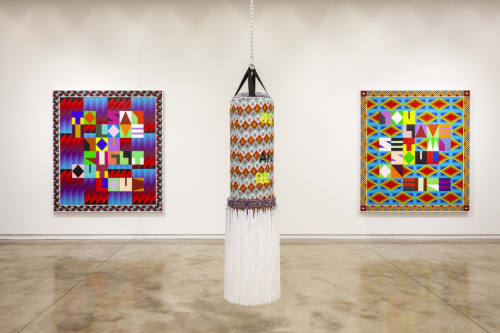CHICAGO — Jeffrey Gibson’s current exhibition is titled CAN YOU FEEL IT, after the classic house remix by Chicago-born DJ Larry Fine, aka Mr. Fingers. The show is packed with paintings, punching bags, and quilts, the last of which are the artist’s first foray into this medium. The remix is a recurring theme for Gibson. It plays a central role in both his formal and conceptual languages: his hard-edged, geometric compositions and day-glow rainbow palettes, as well as references to familiar song lyrics and colloquial expressions, and his incorporation of Indigenous craft techniques and design. These elements come together in Gibson’s ongoing explorations of identity and art history, which have produced a dizzying range of forms over the course of his career.
Gibson’s elegant, weighty punching bags, hanging from the ceiling, are encrusted with plastic and glass beads, most of which spell out phrases or texts from sources as diverse as 20th-century French philosopher Gilles Deleuze (“If you’re trapped in the dream of the Other, you’re fucked”) and Depeche Mode (“All I ever wanted, all I ever needed”). Some of the bags are further adorned with fringe, stones, and other elements used in the making of Indigenous regalia (Gibson’s ancestry is Choctaw-Cherokee).
In the paintings, Gibson challenges viewers to decode messages embedded in vibrant Op Art patterns (imagine a mash-up of Alighiero Boetti and Bridget Riley). The artist’s patterned beading frames them, literally and conceptually. It took some time for my eyes to adjust to being able to read the rune-like lettering in these captivating works. Once the texts revealed themselves, they roamed around my mind as I looked for the source. Some 10 minutes after I deciphered “To say I love you right out loud” I recognized it as a lyric from Joni Mitchell’s “Both Sides, Now.”
While I found Gibson’s new quilts less resolved than the other bodies of work on view, they show nearly limitless potential, integrating scraps of fabric screen printed with words, phrases, or images from Gibson’s past works into textiles co-created with Robert Bemis, an artist without formal training who works primarily in quilt-making. Bemis embellishes the conjoined fabrics with elegant arabesques, retraces lines and forms to accentuate their visual impact, and creates additional texture with extraordinary density, all in thread.
Gibson’s work has always seemed to me exuberant and dedicated to celebration in spite of the specific challenges of daily life. Indeed, the games and humor his works inspire may make me smile, but the emotional heft of their meaning is also achingly present. In this space between desolation and celebration, Gibson is creating the art we need to navigate contemporary existence.

